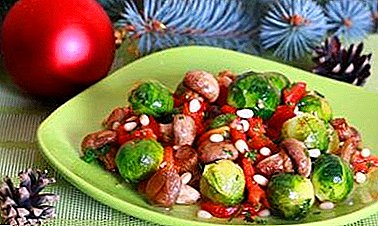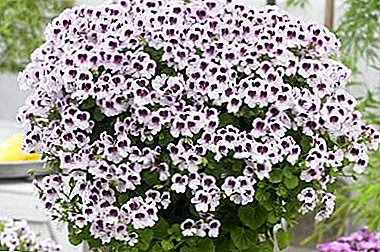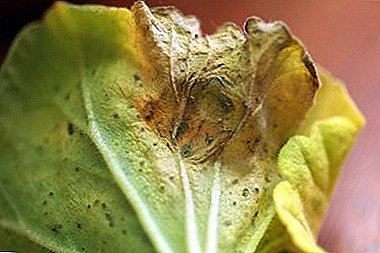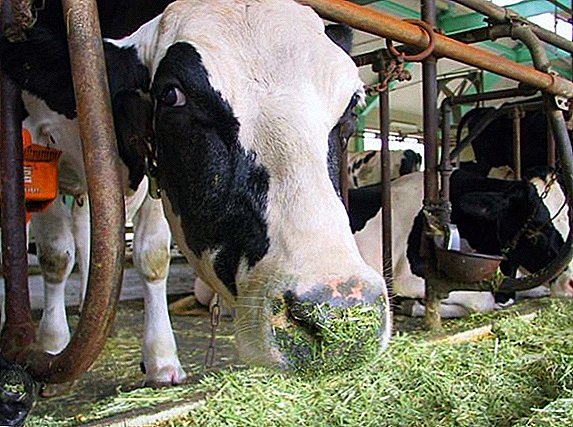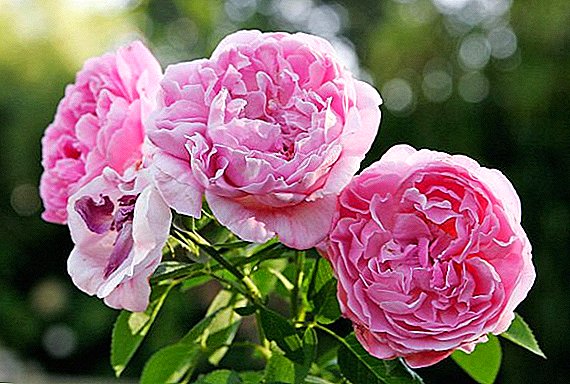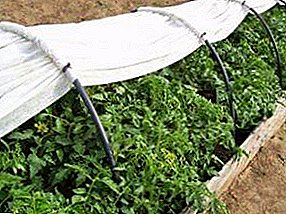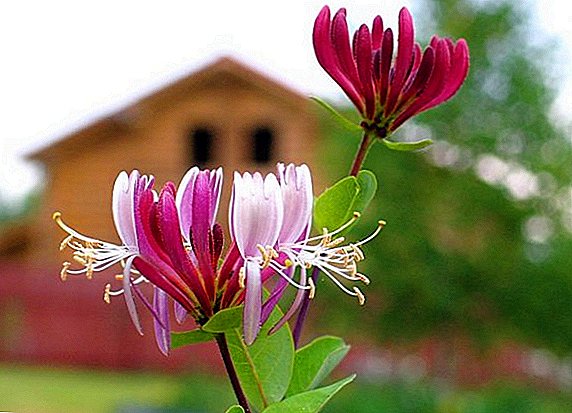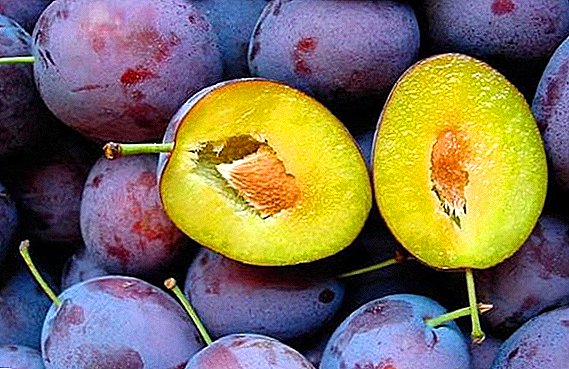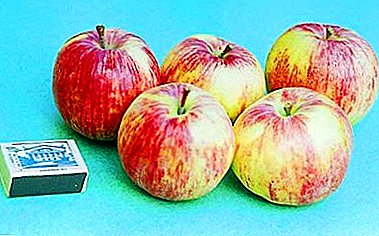
Chinese belfleur - famous dessert variety of appleswho received universal acclaim for their outstanding tastes and impressive size of apples.
And yet the fruits of Bellefleur Chinese are so gorgeous that it will be a matter of honor to grow them for every gardener! Description and photo later in the article.
What kind refers
 Chinese Belfleur - apple variety of medium-sized areas southern zone of the European part of Russia.
Chinese Belfleur - apple variety of medium-sized areas southern zone of the European part of Russia.
In the middle lane refers to autumn varieties, in the south - to the late.
Derived by Michurin himselfThis apple tree was once very popular and widespread in our gardens.
Unfortunately, she could not stand the competition with new varieties, more resistant to cold and disease.
Check out other autumn apple varieties: Aelita, Gala, Lyubava.
Pollination
The best pollinators for Bellefleur Chinese are the following varieties: Cinnamon striped, Autumn striped, Antonovka ordinary, Chinese Saffron. Valid: Slavyanka, Pepin saffron.
Description of the Bellefleur Chinese variety
Consider separately the appearance of the apple and the fruit itself.
Trees tall, powerful. The crown is formed by thick boughs, in shape round and wide. Apple trees bear fruit mainly on long and thin fruit twigs, as well as at the ends of last year's shoots.
Shoots have a light brown color with a reddish tinge, strong-let.
Lentils on the shoots are small, round. The color of the leaves closer to the dark gray.
The leaves are large, have a rounded base, oval or ovate in shape, strongly pubescent.
 The leaf surface is wrinkled, strongly curved, the leaves are folded along the central vein.
The leaf surface is wrinkled, strongly curved, the leaves are folded along the central vein.
The edges of the leaves are wavy, jagged. There are differences in the shape of the teeth, depending on the region of growth: forked teeth in the central regions and crenate in the Lower Volga region and in the south.
Leaf petioles are thick, medium length. There are small stipules of a lanceolate form.
In nurseries, seedlings are tall, with dark brown bark. The leaves on the shoots grow 90º in relation to the stalk.
The fruits of young apple trees are very large. (200-300 g)become a bit smaller with age (120-200 g).
Sometimes apples reach outstanding sizes in the 500-600 g.
Fruits are round, slightly flattened, largely ribbed throughout the length. Calyx closed.
The saucer is quite small, narrow, with folds. Deep funnel of medium diameter.
The funnel skin is sometimes rusty. The stem is of the usual length and thickness, the central fruit have a shorter (do not extend beyond the edges of the funnel). Seed chambers can be closed or half-open.
Seed nest is located closer to the top. Sunflower seeds are large, convex, dark brown.
 Podchashechnaya tubule wide and deep. The tube is cylindrical to funnel shaped.
Podchashechnaya tubule wide and deep. The tube is cylindrical to funnel shaped.
The main color of the fruit is light green, whitening in the process of ripening.
Beautiful cover color: on a fuzzy pink background spills a delicate red-pink blush that takes up at least half of the entire surface of the fruit.
Characterized by the presence of many bright subcutaneous points.
The flesh is juicy, snow-white, dense in texture, fine-grained.
Taste is sweet-sour with special spicy smack. Fruits have a great refreshing taste.
A photo




Breeding history
The author’s variety obtained by the outstanding Russian scientist I.V. Michurin in 1908.
As a result of crossing the American Belfleur yellow with large-fruited chinese the grade turned out to be more adapted to the harsh Russian climate compared to Belfleur yellow.
Growing region
Sort was zoned in the Central Chernozem and North Caucasus regions, Ukraine, Armenia.
Previously, it was widely distributed in the Lower Volga and adjacent areas The Central Chernozem belt, and in the south of the European part of Russia was used as a summer one.
 Gradually, as the emergence of new varieties, more resistant to frost and disease, has lost its former value.
Gradually, as the emergence of new varieties, more resistant to frost and disease, has lost its former value.
Bellefleur Chinese has average frost resistance trees in central regions of Russia freeze cold in especially cold winters, and in wet weather they are affected by scab.
Currently, the variety is approved for use only in North Caucasus region.
Learn more about varieties of apple trees suitable for cultivation in these regions: Avgusta, Melba, Idared, Antonovka dessert, Golden Delicious, Hrusovka winter.
Yield
Yields fluctuate from moderate (in the middle lane) to high (in the south). In the southern areas of the middle zone, young trees have low yields up to until the age of 14-15 years.
After 20 years yields increase up to 150-200 centners per hectare. Apple trees begin to bear fruit relatively late, on average for 6-8 year. Annual fructification, periodicity is weak.
Fruits are removed in the first decade of September. Even very large fruits hold fast on the branches, do not crumble. The main value of the variety is its outstanding taste.
Apples get the best taste after aging. within 2-3 weeks after removal. Fruits tolerate transportation.
For storage, the fruits are sorted by size, taken intact, without dents and scratches. Apples placed in wooden boxes and cleaned in the cellar or basement.
For storage of autumn varieties optimum temperature is about 0ºС. In such conditions, Bellefleur Chinese can be stored up to a maximum of January, and usually until mid-November - early December.
The large fruits of this variety produce especially a lot of ethylene, so they should be stored separately from other fruits and vegetables.
Planting and care
 The best way to get Bellefleur Chinese apples in modern conditions is considered cultivation in the form of vaccinations.
The best way to get Bellefleur Chinese apples in modern conditions is considered cultivation in the form of vaccinations.
So you can avoid all the shortcomings inherent in this variety.
To do this, make several vaccinations in the crown of frost-resistant apple varieties.
Not suitable for this purpose Antonovka, due to poor Chinese compatibility.
Apple Bellefleur Chinese can be successfully grown from seed without the use of grafts.
They are among those varieties that give a high percentage of seedlings with cultural properties, even without observing special conditions when collecting seeds.
A quicker and easier way to grow a Bellefleur Chinese tree is to buy a sapling. Buy seedlings only in verified nurseries at the place of residenceThis is a guarantee that the apple tree will be adapted to the local climate.
The younger the seedling, the better. Before transporting, take care to preserve moisture: wrap the roots with moss, a damp cloth or paper, and wrap in polyethylene.
When buying a seedling in a container carefully look around him and make sure he has young healthy roots.
Planting is carried out in spring or autumn in the standard way. In the middle lane preferably springtime. Trees are planted in the distance not less than 4-6 m and not more than 50 m from each other for pollination.
For the full development of apple trees, neutral, well-fertilized soils rich in potassium and organic matter are most favorable. The soil must be well moistened. The seat for the seedling is prepared in advance.
 If the land is fertile, the trees are planted in pits.
If the land is fertile, the trees are planted in pits.
On loam, sandy, black soil they remove the top layer of earth and make a small depression in 15-20 cm
On sandy soils prepare a large square pit. about 80 cm deep put in it the ground, the moss to retain moisture and nutrients, fall asleep on top of fertile soil.
Planting is done next year.
In the sandy, sandy and podzolic soils contribute organic fertilizer - compost or manure.
Remember that mineral fertilizers and fresh manure can not be applied directly during planting, as they can cause burns.
Clay, peat, as well as wet areas with surface groundwater are not suitable for apple trees.
On these soils for planting prepare the bulk hill.
Landing is most conveniently carried out together. The tree is planted with a peg, which is driven into the center of the planting pit.
The roots of the seedling gently spread on the stake and gradually sprinkled with earth. The root neck should be located 3-5 cm above ground level..
Do not bury the seedling, it will worsen its growth and may even lead to death.
After planting, the seedling is first loosely tied to a peg. After the soil subsides, the tree is tied up carefully, best of all. with the help of three pegs.
 Immediately after planting, the seedling is watered abundantly, even in rainy weather.
Immediately after planting, the seedling is watered abundantly, even in rainy weather.
For this purpose, along the edges of the pits make the hole. Further apple trees provide regular watering.
To retain moisture spend soil mulching sawdust, bark, dung or black film.
In spring, apple trunks are whitewashed to prevent sunburn; it is especially important to do this in sunny climates.
For good harvest and disease prevention regularly carry out pruning of trees.
In the spring, pruning is reduced to the removal of dry branches, as it is undesirable to injure a tree during sap flow.
Krona is formed in the fall after the end of fruiting. During autumn pruning, branches are shortened and thinned, and dried ones are removed. The general rule when pruning: remove competing with the central trunk, vertically growing branches, leaving horizontal. Sections cover garden pitch.
Diseases and pests
Chinese belfleur has low resistance to fungal diseases: scab and powdery mildew. Particularly affected are scab fruits, to a lesser extent leaves.
To prevent disease, trees should be planted at a sufficient distance from each other, prevent thickening of the crown. The scab appears as black spots and growths on the leaves first, and then on the fruits.
Sick leaves are necessary immediately remove and burn.
 Mealy dew manifests in early spring as a dense white bloom on the leaves, shoots and inflorescences.
Mealy dew manifests in early spring as a dense white bloom on the leaves, shoots and inflorescences.
Over time, the plaque darkens, acquiring a red tint, the affected leaves curl and die.
On the fruit whitish plaque turns into a characteristic rusty mesh.
It is necessary to use special preparations for the prevention and treatment of fungus.
Spray three times with fungicides. or Bordeaux liquid, you can also successfully use the new generation of biological products "Healthy Garden", "Charm", "Zircon".
They increase resistance to both scab and powdery mildew, also protect against pests and are harmless to humans.
Feeding trees with potash and phosphate fertilizers significantly increases disease resistance, while excess nitrogen, by contrast, increases the risk of infection.
At present, Bellefleur Chinese is more cultivated as the so-called souvenir variety. Among the minuses - a large height of trees.
More significant shortcomings of the variety are low frost resistance in the middle lane, late onset of fruiting and low yield, as well as high susceptibility to scab and other diseases.
In this regard, in areas of central Russia can be recommended cultivation Belfleur-Chinese in the form of vaccinations.
Watch the video on what powdery mildew is: control and prevention methods.


